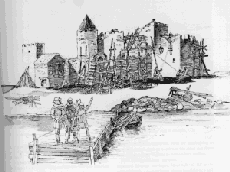Meet the Middle Ages
BackThe town castle

It was in the King’s interest to protect the towns, as they were one of his main sources of income and also provided him with imported goods.
In many of the more important towns of the country, there was a castle, where the Royal Bailiff lived. At the castle were also soldiers who were employed to defend the castle and the town. In times of unrest, the number of soldiers at the castle increased. The King employed both native and foreign soldiers. The Bailiff trained them and gave them their wages. Next to the castle there was a training ground for bow- and crossbow-shooting and sometimes also a training ground for catapults. At war, noblemen and knights as well as peasants from the country could be summoned.
The castle rose above the town. It was a sign of power. The Bailiff belonged to the Council, and was influential in its decisions. The Bailiff also had three days ´ option on merchandise brought to town. In this way, the castle got the best and the finest goods. The bailiff also made sure that people paid their taxes and duties, and that the King was given his share of the fines paid in town. As well as his soldiers, the Bailiff also employed servants, maids and farm-hands who also lived at the castle.
Towns without a castle had a garrison to defend the town. The garrison consisted of mercenary soldiers, hired by the King.